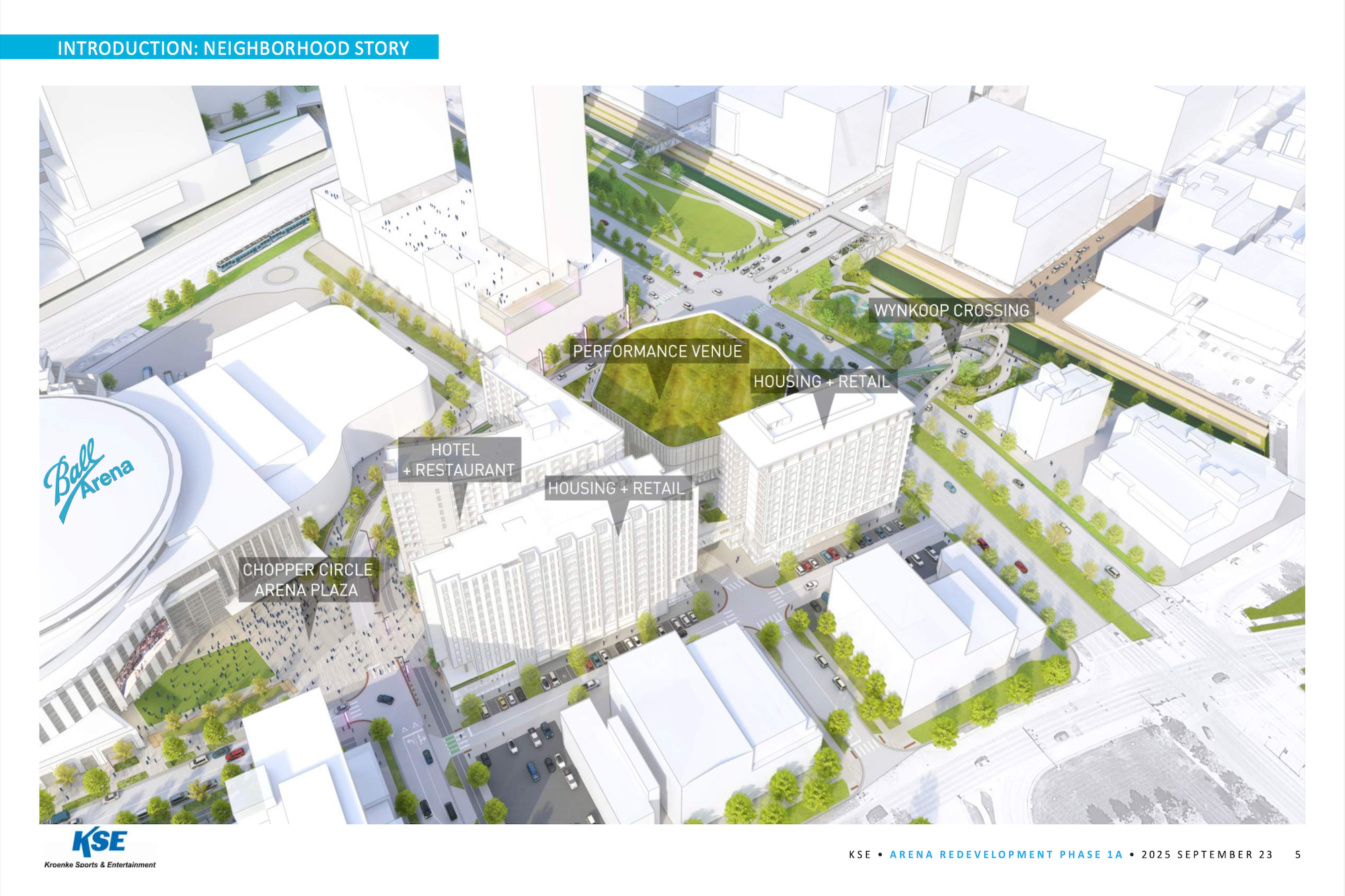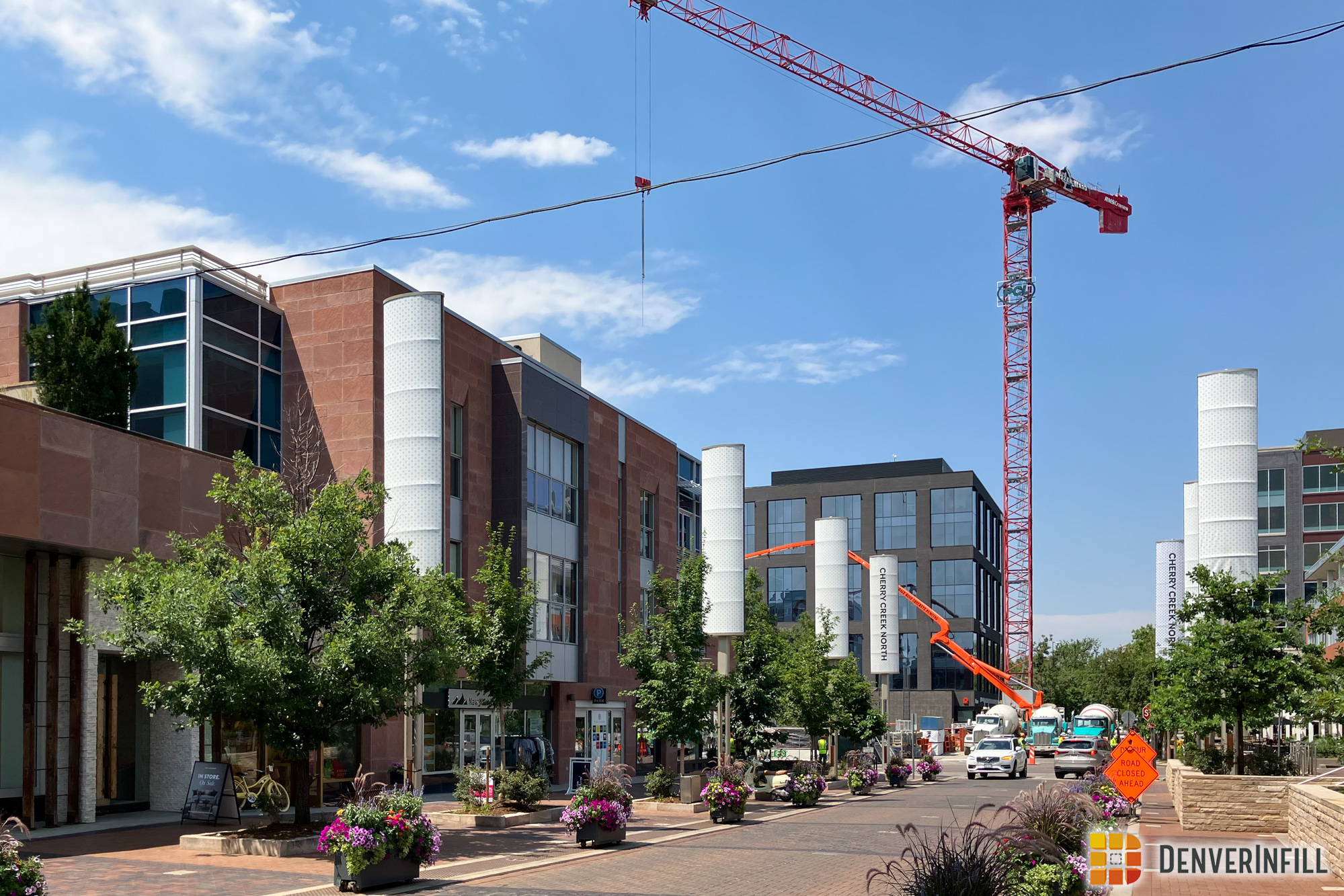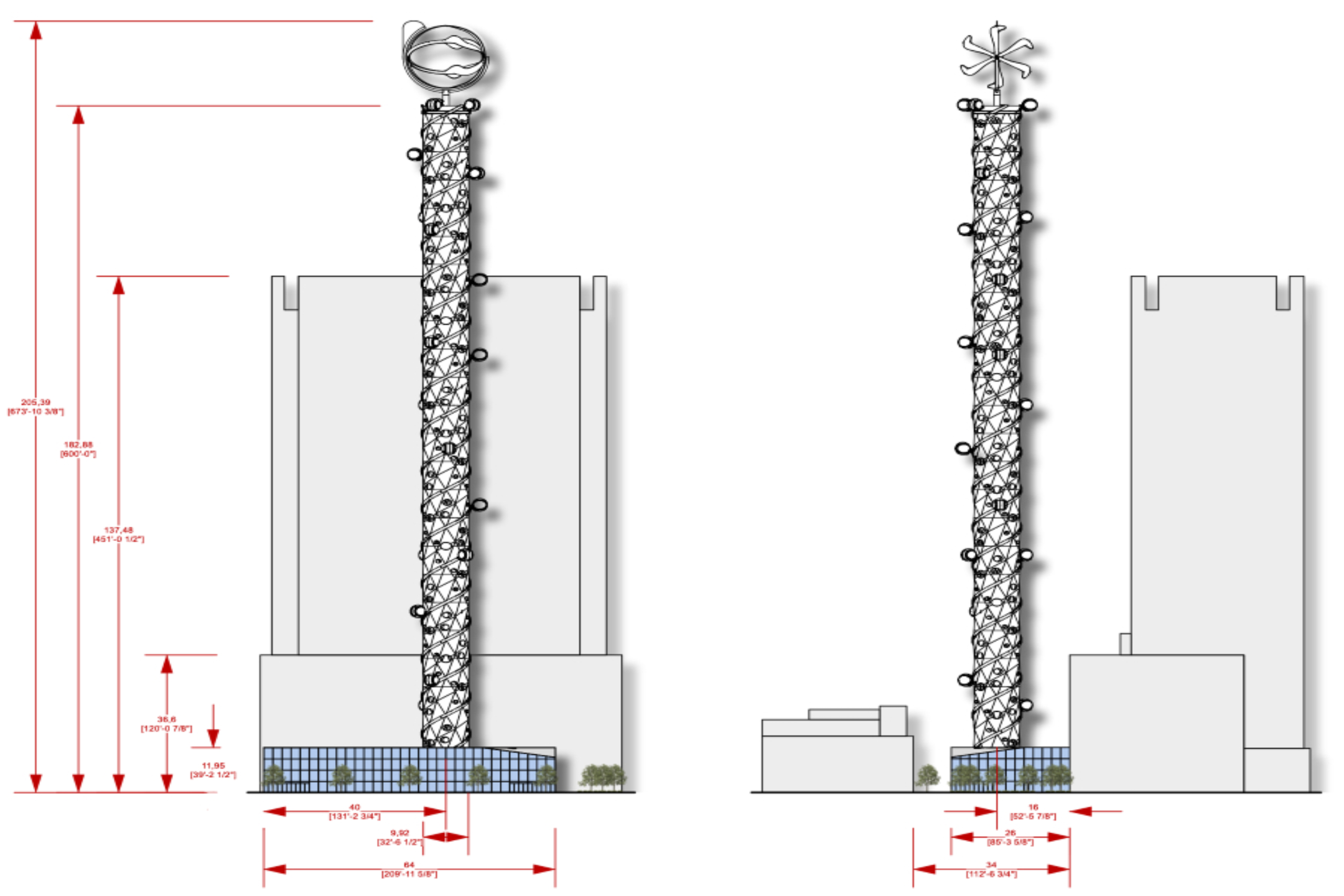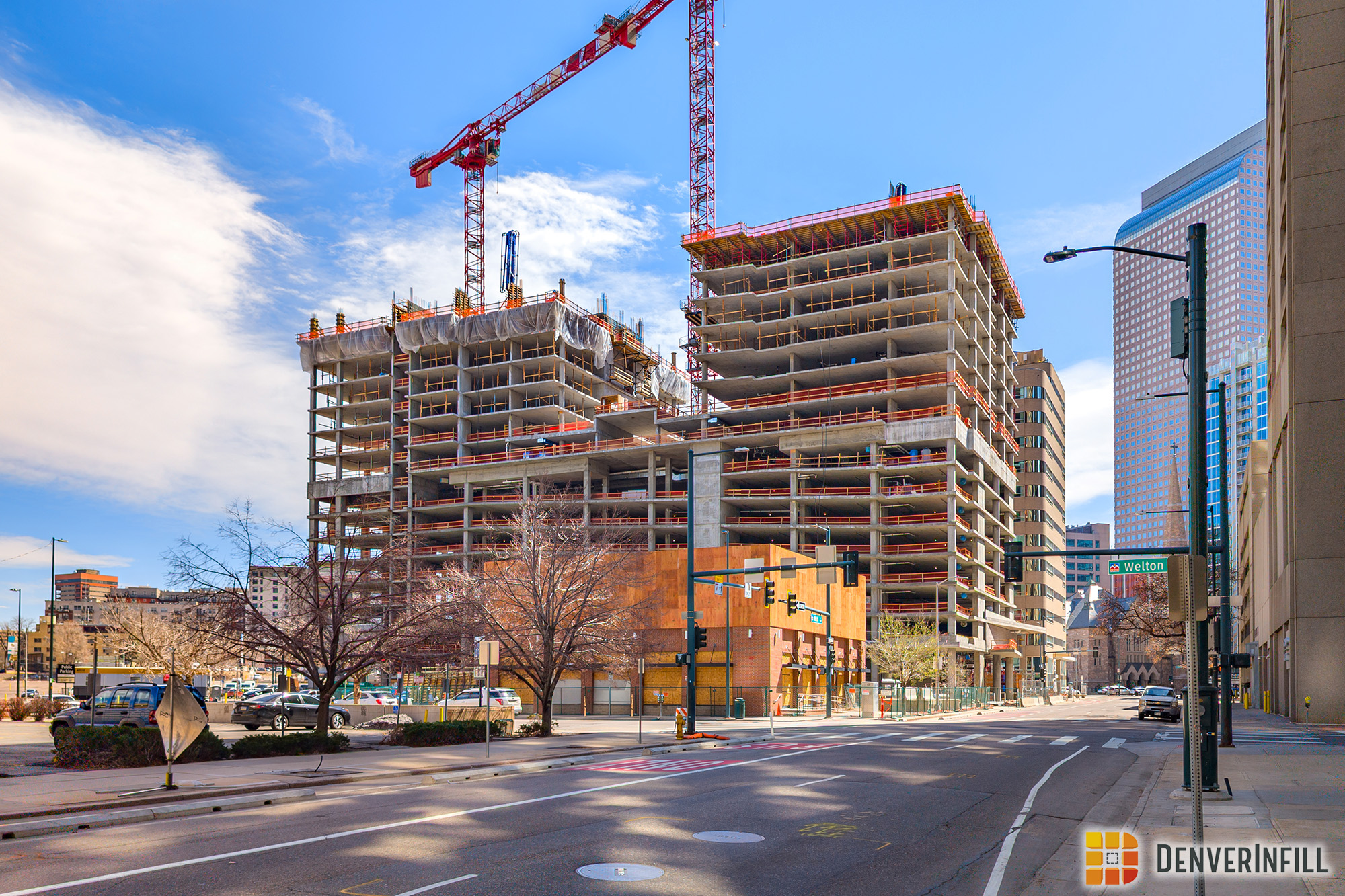A new five-story, 165-room hotel is proposed for a mid-block site along 16th Street between Central and Boulder streets in Lower Highland. Denver-based St. Charles Town Company is the developer. The Google Earth image below shows the approximate outline of the site.
The new hotel will be operated by Starwood Hotel & Resorts Worldwide, Inc. and branded as a Tribute Portfolio property, Starwood’s newest hotel line that features independent boutique hotels in unique urban settings. The official name of the hotel will be released later in 2016.
Currently on the site are three small houses, two surface parking lots, and a 1970s building now used as offices but originally built as a sales center for mountain ski resort condominiums. One of the houses is vacant, another is occupied by Higdon’s Hair Studio (which will move to a new space around the block) and the third has been used by Amato’s Ale House. The entire site is zoned C-MX-5 (commercial mixed use, five-stories). The project’s 16th Street neighbors include a three-story 1920s-era apartment building at the Boulder Street corner and Amato’s at the Central Street corner. Here’s a view of the site:
The new hotel building has not yet been designed, but a concept rendering of the development’s preliminary scale and form was prepared by the project architect, Semple Brown Design, for Starwood’s project announcement two weeks ago:
This concept image shows a five-story building stepping down as it approaches Amato’s to provide a terrace offering great views of the downtown skyline, and a partial setback along 16th Street to create a forecourt for the main pedestrian entry, patio seating, and an engaging sidewalk presence. The project’s several underground parking levels will offer 117 vehicle parking spaces (more may be added as the building’s design evolves) accessed via an entry on 16th Street. As shown on the aerial photo above, the parcel is slightly L-shaped with a small section fronting Kensing Court. Due to the Hirshorn Park View Plane, the building will step down to about one-story high on the Kensing Court side. The hotel will feature a pool and rooftop lounge, as well as an event space, a restaurant, and a neighborhood market.
St. Charles Town Company hopes to break ground in late 2016 or early 2017 with an opening targeted for summer 2018.














While I do like the density and activation provided to the site, it is a shame that the 1876 vintage home just next to Amato’s will be demolished. While the form and massing is appropriately contemporary I sincerely hope they don’t decide to do another stucco monstrosity, especially in place of historic homes.
I agree. It seems there are plenty of other surface lots we could be building on before tearing down the few remaining old homes left in the area.
There are plenty of monstrosities and parking lots that ought to go before historic homes. Did we learn nothing from the Denver Urban Renewal Authority?
It will look just as fugly and uninspiring as everything else in Denver! If the rendering itself is so unappealing and basic, as always, the final result will be 100 times worse, shame on Denver! Also, it will be sad to see those 100 years + old houses torn down,
I know I get a lot of flack on this site for my overtly preservationist mentality, but this is just wrong. The 1970’s building certainly isn’t that old so I guess I can understand tearing it down, though I find it kind of charmingly unique in the sea of faceless modernity that has become the architecture of the Highland neighborhood (and Denver as a whole, actually). But the three old houses are historical gems that by no means should be torn down! I’m so happy that for once I’m not the only one commenting about this. Why does Denver seem so hellbent on destroying every last ounce of architectural history in this city in favor of modern boxes completely void of any character? Aaron is absolutely right in his comment above. The Denver Renewal Authority of the 1970’s was a mistake and I think anyone who has seen the vibrancy of LoDo today can testify to why old buildings, regardless of “importance,” should be preserved and reused! The same should hold true in LoHi and the rest of Denver! Don’t tear down these cool old buildings!
There are a lot of us. I see it every day and just wonder what our mayor is doing.
There are dozens of us! Dozens!
Not to be rude, but why don’t people with your mentality band together, collect donations, and buy these properties? We can’t expect the city to turn Denver into a fossil museum. Then we’d have San Francisco and even higher housing costs.
How is that not a rude comment?
Wow Chris.
First, don’t claim that “preserving” non-unique historic single-family detached homes makes up for the loss of the larger commercial/mixed-use buildings that were destroyed during Denver’s urban renewal period. They are not the same thing and preserving SFD homes will not make up for it.
Second, If it wasn’t for the 70’s “urban renewal” and the concurrent population exodus from cities to suburbs then more than likely those SFD homes would have already been replaced with larger structures because downtown would have continued to grow.
Third, since that illustration is really just a massing study, then you have no idea at this point what the hotel may look like. Wait and see before you start to complain.
Finally, no one can dictate what land gets sold for development and for how much. Owners of parking lots don’t sell because they are making more money as a parking lot. The value of the land would have to rise considerably. Despite the loss of surface lots and the subsequent rise in parking prices, people still drive. Everyone likes cheap parking.
If you want that to change this is what needs to happen.
1) Convince the city to invest in transit improvements and then heavily promote it. This could be additional lines, higher frequencies, better infrastructure. RTD won’t do it since their focus is on regional, commuter transit. Personally, I think the city made a big mistake when it let go of the remnants of the Denver Tramway company.
2) Alter the major streets to provide transit only lanes: Colfax, Broadway, Speer, Federal, Colorado Blvd, etc. Yes, drivers will be a little more inconvenienced but transit will now be faster and more attractive and riders will be better off.
3) Force parking lot owners to make their lots more attractive from level of the pedestrian and keep them that way. This will add cost to the owners which will be passed along to the people who park.
Hopefully, cheap and easy parking will no longer be cheap or easy and drivers will find that taking transit has become the better option. Surface lot owners will find that they are better off selling to a developer instead of holding onto a dying business and those lots will disappear. Then, and only then, will those historic SFD homes be preserved…for a little while longer.
I am not arguing against the economics of why developers tear down buildings yet leave surface parking lots untouched; I understand it. What I am arguing is the lack of ethics at play in development when history is completely disregarded.
It’s not so much a matter of ethics or the lack thereof; it’s only a matter of who is willing to sell their land and who isn’t. You don’t think that developers know that replacing a parking lot would be much easier to than buildings, historical or otherwise? If no one was willing to replace SFD homes, than nothing would ever get built. History is all about replacement.
I agree with you that structures built 100 years ago are far more attractive and interesting than anything built today. But again, that all come down to design and that can be addressed. Save your energy to fight to preserve whatever larger, historical buildings that are still remaining in Denver.
Sign me up for being for this development. Those houses are old, not historic, not really architecturally attractive nor significant. The cost to move them would be astronomical and for what benefit? This is a PRIME area of highlands. I think the actual build will be much more attractive than this rendering.
The happy people in the rendering are all white. Happy white bliss.
I can count at least a couple dozen “minority” people in the rendering. Happy non-racist bliss.
That 70’s ski lodge is absolutely hideous. The 3 old homes have either been remodeled beyond historical recognition or allowed to fall into disrepair. Bring on the Happy White Bliss Hotel! Kinda just rolls off the tongue…
Just for my own clarification, you said the entire site is C-MX-5 and that it is commercial mixed use to five stories. But, I thought the ‘C’ was for “Urban Center”. Is that synonymous with Commercial? What is that first letter/definition even mean in the scheme of things? Thanks for clarifying.
I live near this area and welcome the upgrade. One of the homes has been vacant the 4 years I have lived here and the office building looks horrible. While I understand the desire to keep older places, this area needs a hotel and I can’t wait for it to be done.